
The Battle of the Coral Sea, from 4 to 8 May 1942, was a major naval battle between the Imperial Japanese Navy (IJN) and naval and air forces of the United States and Australia. Taking place in the Pacific Theatre of World War II, the battle was the first naval action in which the opposing fleets neither sighted nor fired upon one another, attacking over the horizon from aircraft carriers instead.
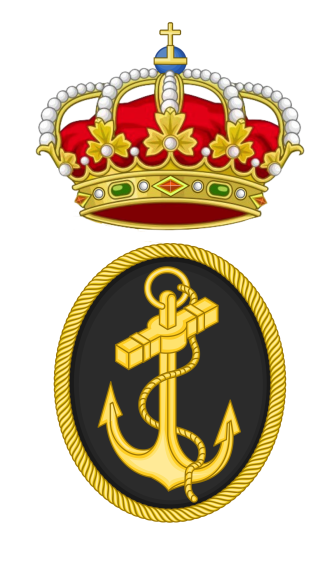
The Spanish Navy or officially, the Armada, is the maritime branch of the Spanish Armed Forces and one of the oldest active naval forces in the world. The Spanish Navy was responsible for a number of major historic achievements in navigation, the most famous being the discovery of America and the first global circumnavigation by Elcano. For several centuries, it played a crucial logistical role in the expansion and consolidation of the Spanish Empire, and defended a vast trade network across the Atlantic Ocean between the Americas and Europe, and the Manila Galleon across the Pacific Ocean between the Philippines and the Americas.

The United States Pacific Fleet (USPACFLT) is a theater-level component command of the United States Navy, located in the Pacific Ocean. It provides naval forces to the Indo-Pacific Command. Fleet headquarters is at Joint Base Pearl Harbor–Hickam, Hawaii, with large secondary facilities at Naval Air Station North Island, California.

USS Enterprise (CV-6) was a Yorktown-class carrier built for the United States Navy during the 1930s. She was the seventh U.S. Navy vessel of that name. Colloquially called "The Big E", she was the sixth aircraft carrier of the United States Navy. Launched in 1936, she was the only Yorktown-class and one of only three American carriers commissioned before World War II to survive the war. She participated in more major actions of the war against Japan than any other United States ship. These actions included the attack on Pearl Harbor — 18 Douglas SBD Dauntless dive bombers of her air group arrived over the harbor during the attack; seven were shot down with eight airmen killed and two wounded, making her the only American aircraft carrier with men at Pearl Harbor during the attack and the first to sustain casualties during the Pacific War — the Battle of Midway, the Battle of the Eastern Solomons, the Battle of the Santa Cruz Islands, various other air-sea engagements during the Guadalcanal Campaign, the Battle of the Philippine Sea, and the Battle of Leyte Gulf. Enterprise earned 20 battle stars, the most for any U.S. warship in World War II, and was the most decorated U.S. ship of World War II. She was also the first American ship to sink a full-sized enemy warship after the Pacific War had been declared when her aircraft sank the Japanese submarine I-70 on 10 December 1941. On three occasions during the war, the Japanese announced that she had been sunk in battle, inspiring her nickname "The Grey Ghost". By the end of the war, her planes and guns had downed 911 enemy planes, sunk 71 ships, and damaged or destroyed 192 more.

USS Washington (BB-56) was the second and final member of the North Carolina class of fast battleships, the first vessel of the type built for the United States Navy. Built under the Washington Treaty system, North Carolina's design was limited in displacement and armament, though the United States used a clause in the Second London Naval Treaty to increase the main battery from the original armament of nine 14 in (356 mm) guns to nine 16 in (406 mm) guns. The ship was laid down in 1938 and completed in May 1941, while the United States was still neutral during World War II. Her initial career was spent training along the East Coast of the United States until Japan attacked Pearl Harbor on 7 December 1941, bringing the United States into the war.
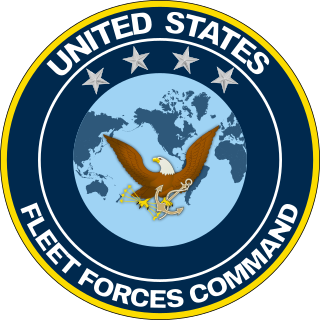
The United States Fleet Forces Command (USFF) is a service component command of the United States Navy that provides naval forces to a wide variety of U.S. forces. The naval resources may be allocated to Combatant Commanders such as United States Northern Command (USNORTHCOM) under the authority of the Secretary of Defense. Originally formed as United States Atlantic Fleet (USLANTFLT) in 1906, it has been an integral part of the defense of the United States of America since the early 20th century. In 2002, the Fleet comprised over 118,000 Navy and Marine Corps personnel serving on 186 ships and in 1,300 aircraft, with an area of responsibility ranging over most of the Atlantic Ocean from the North Pole to the South Pole, the Caribbean Sea, Gulf of Mexico, and the waters of the Pacific Ocean along the coasts of Central and South America.

The Sixth Fleet is a numbered fleet of the United States Navy operating as part of United States Naval Forces Europe-Africa. The Sixth Fleet is headquartered at Naval Support Activity Naples, Italy. The officially stated mission of the Sixth Fleet in 2011 is that it "conducts the full range of Maritime Operations and Theater Security Cooperation missions, in concert with coalition, joint, interagency, and other parties, in order to advance security and stability in Europe and Africa." The current commander of the Sixth Fleet is Vice Admiral Thomas E. Ishee.

The Fast Carrier Task Force was the main striking force of the United States Navy in the Pacific War from January 1944 through the end of the war in September 1945. The task force was made up of several separate task groups, each typically built around three to four aircraft carriers and their supporting vessels. The support vessels were screening destroyers, cruisers, and the newly built fast battleships.

The Seventh Fleet is a numbered fleet of the United States Navy. It is headquartered at U.S. Fleet Activities Yokosuka, in Yokosuka, Kanagawa Prefecture, Japan. It is part of the United States Pacific Fleet. At present, it is the largest of the forward-deployed U.S. fleets, with 50 to 70 ships, 150 aircraft and 27,000 Sailors and Marines. Its principal responsibilities are to provide joint command in natural disaster or military operations and operational command of all U.S. naval forces in the region.

The Russian Naval Infantry, often referred to as Russian Marines in the West, operate as the naval infantry of the Russian Navy. Established in 1705, they are capable of conducting amphibious operations as well as operating as more traditional light infantry.

The Fifth Fleet is a numbered fleet of the United States Navy. Its area of responsibility encompasses approximately 2.5 million square miles, and includes the Persian Gulf, Red Sea, Arabian Sea, and parts of the Indian Ocean. It shares a commander and headquarters with U.S. Naval Forces Central Command (NAVCENT) in Bahrain. Fifth Fleet/NAVCENT is a component command of, and reports to, U.S. Central Command (CENTCOM).
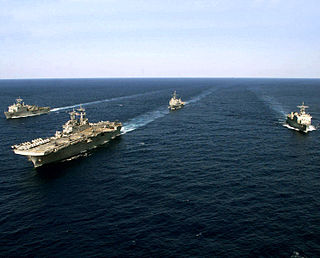
An amphibious ready group (ARG) of the United States Navy consists of a naval element—a group of warships known as an Amphibious Task Force (ATF)—and a landing force (LF) of U.S. Marines, in total about 5,000 people. Together, these elements and supporting units are trained, organized, and equipped to perform amphibious operations.

Task Force 20 is a temporary combat force designation that has been used several times and may still be used by separate parts of the United States armed forces. The longer-established iteration was a part of the United States Second Fleet in the Atlantic from after the Second World War. This was part of the formal United States Military Communications-Electronic Board system.
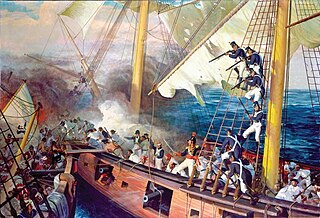
Marines, or naval infantry, are soldiers who specialise at operating in littoral zones, both on land and at sea. Historically, the main tasks undertaken by marines have included raiding ashore in support of naval objectives, and the boarding of vessels during combat or capture of prize ships. Marines also help maintain discipline and order aboard the ship. In most countries, marines are an integral part of that state's navy.

For decades, Task Force 77 was the aircraft carrier battle/strike force of the United States Seventh Fleet in the United States Navy (USN), a designation lasting from the final year of the Second World War until the disestablishment of the task force in 2000.
The structure of the United States Navy consists of four main bodies: the Office of the Secretary of the Navy, the Office of the Chief of Naval Operations, the operating forces, and the Shore Establishment.
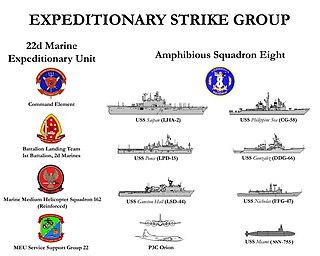
In the United States Navy, the expeditionary strike group (ESG) is a coordinated group of surface ships, aircraft, submarines, and other naval assets. In contrast to carrier strike groups (CSGs), which emphasize air power and are led by a supercarrier, ESGs are strongly suited for amphibious warfare and are led by an amphibious assault ship. The ESG concept was introduced in the early 1990s, based on the Naval Expeditionary Task Force. The U.S. Navy fields nine expeditionary strike groups.

USS Windsor (APA-55) was a Windsor-class attack transport in service with the United States Navy from 1943 to 1946. She was scrapped in 1972.

The invasion of Salamaua–Lae, called Operation SR by the Japanese, was an operation by Imperial Japanese forces to occupy the Salamaua–Lae area in the Territory of New Guinea during the Pacific campaign of World War II. The Japanese invaded and occupied the location in order to construct an airfield and establish a base to cover and support the advance of Japanese forces into the eastern New Guinea and Coral Sea areas. As the Japanese arrived, the tiny Australian garrison in the region retreated and did not oppose the invasion.

A series of operations by American aircraft carriers were undertaken in the first half of 1942 in response to the Japanese attack on Pearl Harbor. Six American air-naval operations conducted from January to the end of April 1942 were aimed at harassing Japan during the height of the Japanese offensive in Southeast Asia, improving the morale of the American forces, which had deteriorated after the attack on Pearl Harbor, and also showing Japan that despite all the defeats of the Allies during this time, United States Navy can carry out effective strikes. The last of these raids directly accelerated the Japanese attack on Midway, which had strategic consequences for the Pacific War.


















